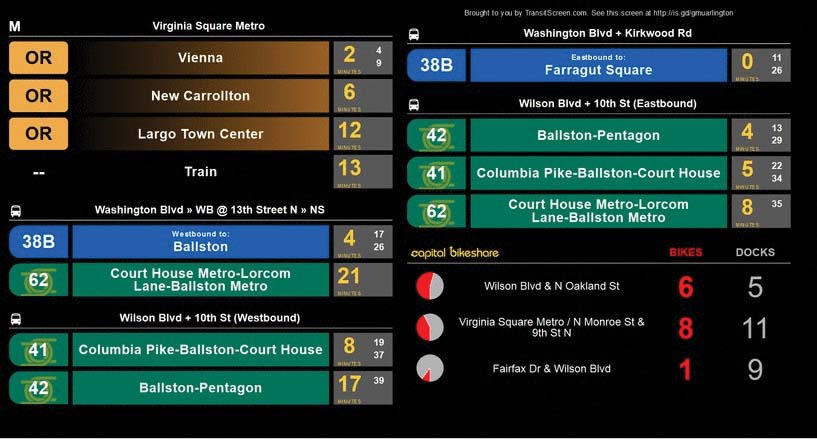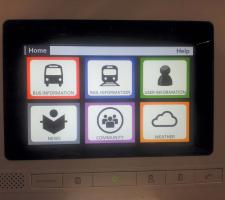
A TransitScreen display in a commercial building in Washington DC
David Crawford finds resurgent interest in travel information screens for buildings.
With city governments worldwide increasingly opening up and sharing their public transport data for general use, attention is focusing on the potential financial benefits – to transit operators and businesses more widely. Professor Stephen Goldsmith, who directs the US’ Harvard University’s Data-Smart City Solutions Project says: “Amid Nationwide public-sector budget cuts, open data is providing a road map for improving transit and engaging an increasingly tech-savvy citizenry.”
There is, he says, no “silver bullet” to attract transit ridership; but implementing ITS is recognised as one approach. In turn, “public transit not only produces an immense volume of data, but it also stands to benefit from good analysis in the form of streamlined operations and a better rider experience.”
Goldsmith points out that over 200 transit agencies worldwide are now taking advantage of the opportunity to publish their schedules, fares and station locations to a common-format Google TransitDataFeed (GTFS) specification. Widely adopted as a de facto worldwide standard, GTFS powers Google Transit and other apps.
The field has grown with the emergence of the Google Transit data tool for small transit agencies lacking the resources to host the necessary data feeds. Developed under the US856 Transportation Research Board’s Transit Innovations Deserving Exploratory Analysis (IDEA) programme, this is available as a web-based application released under an open source software licence.
The widening world of open data availability is generating a deluge of mobile apps designed to deliver transit information to people on the move. But there is still an active – and growing - market for static displays, linked – among other factors in the US - to the increasing importance of transit-accessible location in real estate markets.
A recent arrival in the field is US multimodal information display start-up TransitScreen, founded in 2012. Having started out in the Washington DC area, the company has entered 2014 with the announcement of plans to cover all North American regions that offer open transit data by 2015.
Its web-based, real-time platform is hardware neutral and is designed for display on any device that can access the web - kiosk, building lobby television, a screen at a transit stop or station, or a personal device. Cloud hosting, says company president Matt Caywood, “helps us maintain reliability”.
The system is on offer for use by building owners – typically in lobbies - in any large metropolitan area providing open transit data. It draws together data streams from distinct agencies for presentation on large screens in multi-occupied residential and commercial properties.
In the next few months the company will be announcing a licenced, employer-focused offering which would provide employees access to a web version. The information can include carsharing, bikesharing and walking options alongside commuter rail, metro, bus and tram services.
Says Caywood: “Our product is in demand because no app - or combination of apps - offers the convenience of at-a-glance digital signage, especially for multimodal transit. Passenger information displays will be relevant well into the future - but they will become web-based and smarter, rather than using legacy hardware”.
In addition, a 2013 US study found that 45% of adults don’t have smartphones, indicating a huge market of transit users that aren’t being reached with apps.
TransitScreen started under the15 Aegis of Mobility Lab, a transit research and development think tank initiative by Arlington County Commuter Services in the Washington DC metropolitan area, which was set up to encourage multimodal travel. The saga began with a Lab fellowship for Caywood, who was working with colleagues on ways to make transit easier to use.
He says: “We had to figure out how to bring all the services together. Our goal is to bring all the relevant information to the user in 10 seconds.
“We have chosen this metric based on TransitTalent.com’s Psychology of Wayfinding report. Travellers are often in a hurry and, if their questions are not answered within about ten seconds, they will move on. We have designed our software to achieve this.”
Following the four months fellowship, during which TransitScreen was largely developed, the founders began to grow the company – initially in Arlington, and then across Washington, DC. Then came the first screen in San Francisco - in ParkMerced, the city’s largest apartment complex - followed by New York, Boston, Chicago, Los Angeles and Portland (Oregon) in the US, along with Toronto and Vancouver in Canada.
Caywood says: “The expansion, from a technical perspective, was fairly easy, thanks to our focus on first solving the problems of DC – the perfect place to start the experiment as 70% of the population travel intermodally.
“It’s a city committed to transit-oriented development with a population open to trying new things. It helps if decision-makers are familiar with transit and, in Washington and Arlington, they use it.”
At the same time, he points out that a large percentage of travellers only ever consider the regional Metrorail as an option, and sees one of his challenges as convincing them to use other alternatives. “Buses are very mysterious; people see them and don’t know where they go or where they come from.
“Because of this uncertainty many North American travellers prefer rail. We have observed that awareness of bus options improve among our users, and we are currently participating in a study in this area.
“Washington DC and San Francisco are very similar in many respects; both have high population density and an abundance of transportation mode choices which support car-free residents well, and transit agencies with open data policies. A number of Canadian cities have the same characteristics.”
One challenge has been what Caywood describes as “the current lack of real-time transit data standards, presenting technical issues that we have been able to solve.” Adoption of GTFS-RT – the real-time successor to GTFS - has been slower than he expected.
Another issue is the need for relevant alerts on delays and diversions, which is going to be increasingly important in maintaining transit credibility. Agencies, says Caywood, are now starting to make the information available – “but, again, standardisation has been slow.”
The initiative seems timely in reflecting, and responding to, the growing importance of good transit accessibility in real estate decision-making, with the displays allowing building owners to demonstrate the desirability of their location ‘at a glance’. Caywood says one client called TransitScreen ‘the best lobby amenity for the money’ he’d ever seen.
US real estate consultants Cushman & Wakefield have surveyed office rents in the Rosslyn-Ballston corridor of the Washington DC metropolitan area. In the area there are 101 office properties totalling 1.1 million square metres in area, 92% of which is within 400m of one of the five local Metrorail stations.
Comments managing director of research Paula Munger: “People don’t like to walk more than 10 minutes. They don’t want to take a shuttle, they want to walk to their office. So being farther out just doesn’t attract the tenants that being near Metrorail does.”
The consultancy also looked at the rents in apartment buildings with good Metrorail access. They found that blocks on top of, or within 80m of, stations commanded a premium of 23% over average rents for the area, while those more than 400m away were offering an 18% discount. “Investors know this, so they are buying properties that are on or near Metrorail,” says Munger.
Looking beyond 2015, Caywood sees expansion of TransitScreen to Europe and Asia as a logical next step. In Europe, the company will be competing with a real-time passenger information system developed by Australia-headquartered6256 Vix Technologies, offering in-home portals for private dwellings (in a ‘kitchen as travel/community information centre’ concept) and off-route portals for the foyers of large buildings with substantial people flows.
Vix Technologies has now installed over 2,000 in-house portals in two large English housing schemes where local governments have made this a condition of granting planning consent for construction. (They have powers to require developers to deliver specified community benefits, such as to implement policies aimed at discouraging car use).
In one area, the greener travel benefits proved sufficient to help overcome objections by Friends of the Earth to new large-scale developments. (The UK’s Building Research Establishment Environmental Assessment Method (BREEAM) also rewards public transport-friendly designs).
Some 300 off-route portals are also operational. These connect with the system via building owners’ intranets; the in-home ones via residents’ broadband hubs. Automatic delay and diversion alert functions are expected to be operational for both types by the end of this year.
With city governments worldwide increasingly opening up and sharing their public transport data for general use, attention is focusing on the potential financial benefits – to transit operators and businesses more widely. Professor Stephen Goldsmith, who directs the US’ Harvard University’s Data-Smart City Solutions Project says: “Amid Nationwide public-sector budget cuts, open data is providing a road map for improving transit and engaging an increasingly tech-savvy citizenry.”
There is, he says, no “silver bullet” to attract transit ridership; but implementing ITS is recognised as one approach. In turn, “public transit not only produces an immense volume of data, but it also stands to benefit from good analysis in the form of streamlined operations and a better rider experience.”
Goldsmith points out that over 200 transit agencies worldwide are now taking advantage of the opportunity to publish their schedules, fares and station locations to a common-format Google TransitDataFeed (GTFS) specification. Widely adopted as a de facto worldwide standard, GTFS powers Google Transit and other apps.
The field has grown with the emergence of the Google Transit data tool for small transit agencies lacking the resources to host the necessary data feeds. Developed under the US
The widening world of open data availability is generating a deluge of mobile apps designed to deliver transit information to people on the move. But there is still an active – and growing - market for static displays, linked – among other factors in the US - to the increasing importance of transit-accessible location in real estate markets.
A recent arrival in the field is US multimodal information display start-up TransitScreen, founded in 2012. Having started out in the Washington DC area, the company has entered 2014 with the announcement of plans to cover all North American regions that offer open transit data by 2015.
Its web-based, real-time platform is hardware neutral and is designed for display on any device that can access the web - kiosk, building lobby television, a screen at a transit stop or station, or a personal device. Cloud hosting, says company president Matt Caywood, “helps us maintain reliability”.
The system is on offer for use by building owners – typically in lobbies - in any large metropolitan area providing open transit data. It draws together data streams from distinct agencies for presentation on large screens in multi-occupied residential and commercial properties.
In the next few months the company will be announcing a licenced, employer-focused offering which would provide employees access to a web version. The information can include carsharing, bikesharing and walking options alongside commuter rail, metro, bus and tram services.
Says Caywood: “Our product is in demand because no app - or combination of apps - offers the convenience of at-a-glance digital signage, especially for multimodal transit. Passenger information displays will be relevant well into the future - but they will become web-based and smarter, rather than using legacy hardware”.
In addition, a 2013 US study found that 45% of adults don’t have smartphones, indicating a huge market of transit users that aren’t being reached with apps.
TransitScreen started under the
He says: “We had to figure out how to bring all the services together. Our goal is to bring all the relevant information to the user in 10 seconds.
“We have chosen this metric based on TransitTalent.com’s Psychology of Wayfinding report. Travellers are often in a hurry and, if their questions are not answered within about ten seconds, they will move on. We have designed our software to achieve this.”
Following the four months fellowship, during which TransitScreen was largely developed, the founders began to grow the company – initially in Arlington, and then across Washington, DC. Then came the first screen in San Francisco - in ParkMerced, the city’s largest apartment complex - followed by New York, Boston, Chicago, Los Angeles and Portland (Oregon) in the US, along with Toronto and Vancouver in Canada.
Caywood says: “The expansion, from a technical perspective, was fairly easy, thanks to our focus on first solving the problems of DC – the perfect place to start the experiment as 70% of the population travel intermodally.
“It’s a city committed to transit-oriented development with a population open to trying new things. It helps if decision-makers are familiar with transit and, in Washington and Arlington, they use it.”
At the same time, he points out that a large percentage of travellers only ever consider the regional Metrorail as an option, and sees one of his challenges as convincing them to use other alternatives. “Buses are very mysterious; people see them and don’t know where they go or where they come from.
“Because of this uncertainty many North American travellers prefer rail. We have observed that awareness of bus options improve among our users, and we are currently participating in a study in this area.
“Washington DC and San Francisco are very similar in many respects; both have high population density and an abundance of transportation mode choices which support car-free residents well, and transit agencies with open data policies. A number of Canadian cities have the same characteristics.”
One challenge has been what Caywood describes as “the current lack of real-time transit data standards, presenting technical issues that we have been able to solve.” Adoption of GTFS-RT – the real-time successor to GTFS - has been slower than he expected.
Another issue is the need for relevant alerts on delays and diversions, which is going to be increasingly important in maintaining transit credibility. Agencies, says Caywood, are now starting to make the information available – “but, again, standardisation has been slow.”
The initiative seems timely in reflecting, and responding to, the growing importance of good transit accessibility in real estate decision-making, with the displays allowing building owners to demonstrate the desirability of their location ‘at a glance’. Caywood says one client called TransitScreen ‘the best lobby amenity for the money’ he’d ever seen.
US real estate consultants Cushman & Wakefield have surveyed office rents in the Rosslyn-Ballston corridor of the Washington DC metropolitan area. In the area there are 101 office properties totalling 1.1 million square metres in area, 92% of which is within 400m of one of the five local Metrorail stations.
Comments managing director of research Paula Munger: “People don’t like to walk more than 10 minutes. They don’t want to take a shuttle, they want to walk to their office. So being farther out just doesn’t attract the tenants that being near Metrorail does.”
The consultancy also looked at the rents in apartment buildings with good Metrorail access. They found that blocks on top of, or within 80m of, stations commanded a premium of 23% over average rents for the area, while those more than 400m away were offering an 18% discount. “Investors know this, so they are buying properties that are on or near Metrorail,” says Munger.
Looking beyond 2015, Caywood sees expansion of TransitScreen to Europe and Asia as a logical next step. In Europe, the company will be competing with a real-time passenger information system developed by Australia-headquartered
Vix Technologies has now installed over 2,000 in-house portals in two large English housing schemes where local governments have made this a condition of granting planning consent for construction. (They have powers to require developers to deliver specified community benefits, such as to implement policies aimed at discouraging car use).
In one area, the greener travel benefits proved sufficient to help overcome objections by Friends of the Earth to new large-scale developments. (The UK’s Building Research Establishment Environmental Assessment Method (BREEAM) also rewards public transport-friendly designs).
Some 300 off-route portals are also operational. These connect with the system via building owners’ intranets; the in-home ones via residents’ broadband hubs. Automatic delay and diversion alert functions are expected to be operational for both types by the end of this year.







